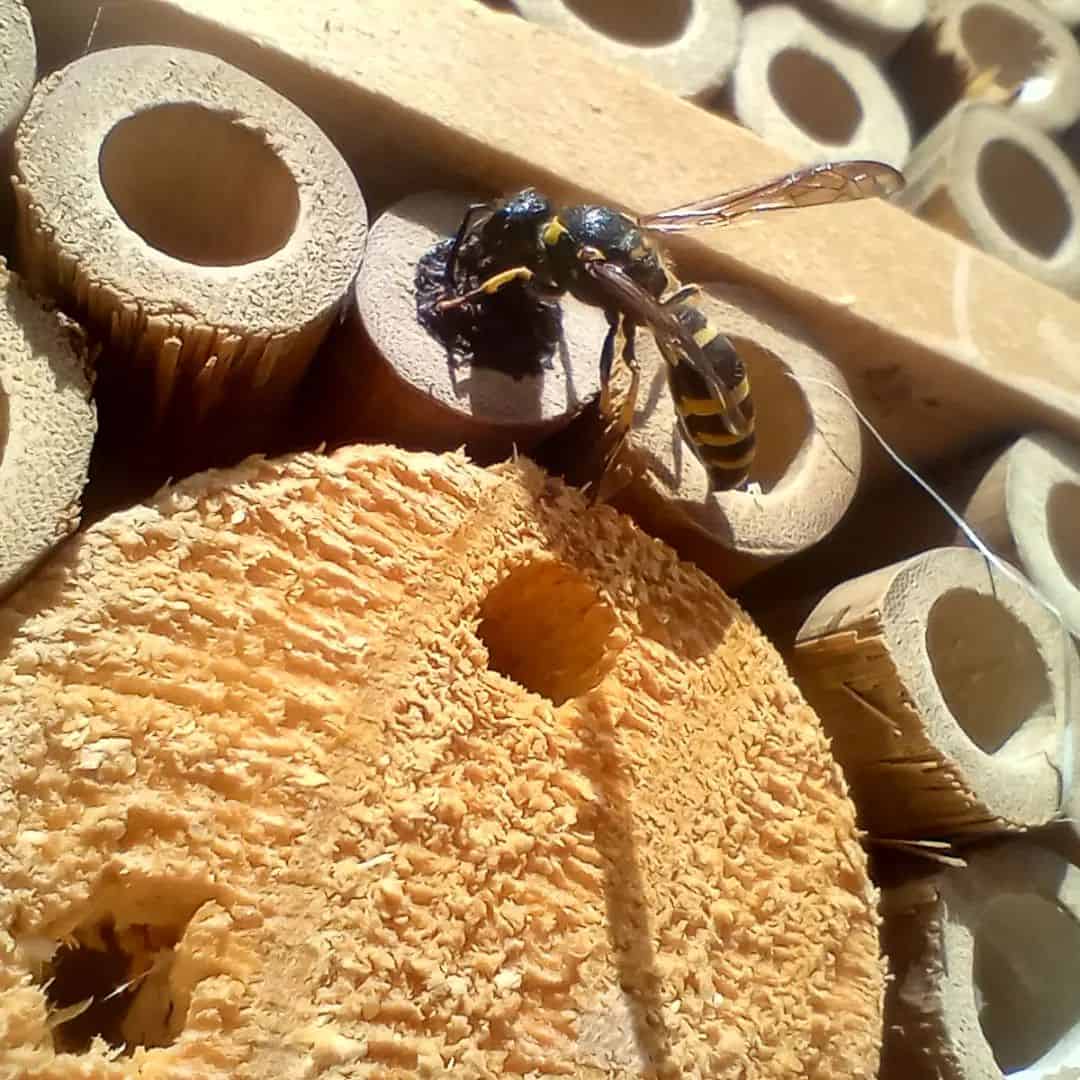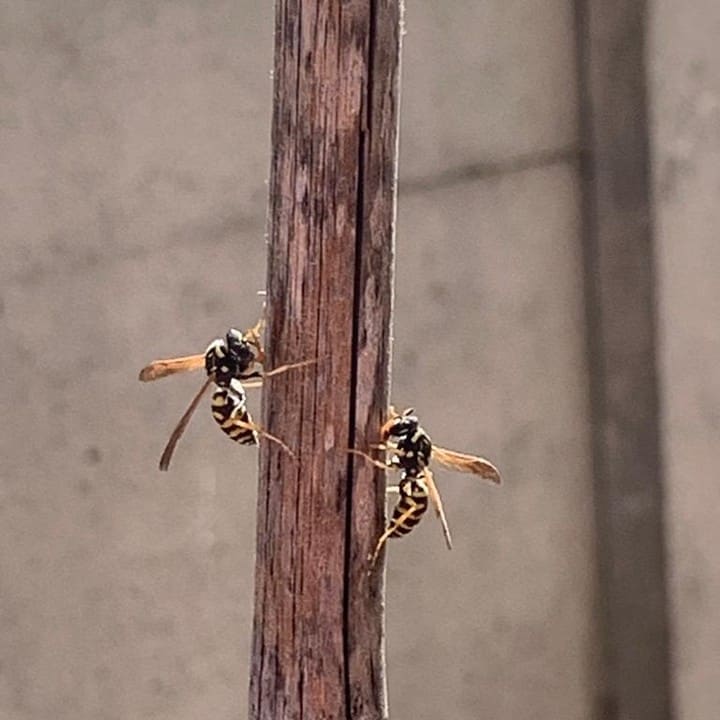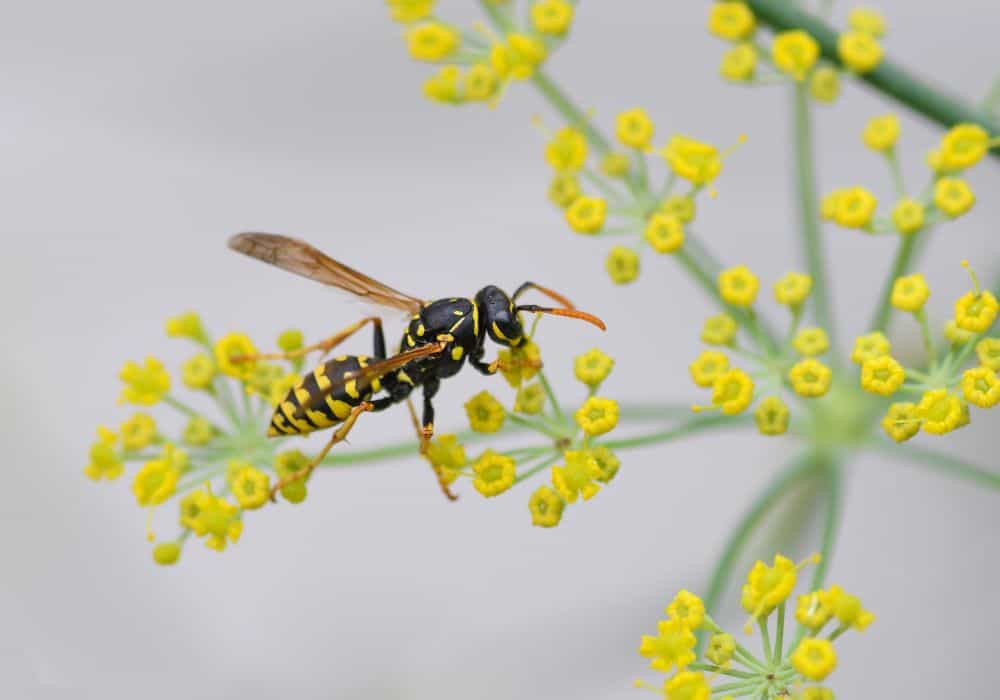Wasps are narrow-waisted insects that are often mistaken for bees due to their similarly painful stings. While bees are loved and doted upon because of their cute colors and honey-making abilities, wasps are commonly seen as the less exciting insects with shiny stingers.
However, wasps are not as uninteresting as you may think. These winged insects, while not as hairy or colorful as bees, play a massive role in ensuring the proper running of the ecosystem. So, this begs the question, do wasps make honey? And what makes them unique?
While wasps are generally not honey makers, there are however some wasp species that make honey like bees but in lesser quantities. One such species is the Mexican Honey Wasp, often found in Central and South America.
Even though Mexican honey wasps can produce honey, it will be unlikely to find wasp honey in jars being sold as bee honey because of how little can be harvested at a time.
Do Wasps Make Honey As Bees Do?

Image Credit: botanicmoments
Bees collect sweet nectar from flowers and use it to produce honey through regurgitation, while wasps feed mainly on insects and whatever sugary substances are available (sometimes nectar).
Wasps cannot break down nectar into honey like bees do, as they lack the proper enzymes for this activity. So, they sometimes feed their larvae with insects and are rewarded with a sugary secretion which can be referred to as honey.
The honey produced by wasps differs from bees as it can only be harvested in small quantities compared to bee honey and is technically made as a food source for larger wasps.
Among the thousands of wasp species known to man, only about 17 are honey-producing. This includes species like the Mexican Honey Wasp, also known as Brachygastra mellifica, and the Black Paper Wasp, also called Brachygastra lecheguana.
How do Wasps Produce Honey?
The honey-making process for wasps is quite different from that of bees. Bees are efficient pollinators due to their hairy bodies, and the result of their pollination process comes out as honey. On the other hand, wasps don’t have as much hair as bees do and aren’t good pollinators. How, then, do wasps produce honey?
As mentioned earlier, wasps are carnivorous and do not feed solely on nectar like bees. Wasps consume several species of field insects, including flies, grasshoppers, caterpillars, beetles, and spiders.
They also capture these insects and bring them back to their larvae as food. The larvae then secrete the sugary substance, which the adult wasps consume as a source of energy to back out there, hunt for more insects, and bring them to feed their prey. It’s a mutually beneficial relationship.
This sugary substance can be called wasp honey, even though it differs in taste and consistency from bee honey. Wasp honey is technically larval saliva and can only be found in certain wasp colonies and structures similar to bees.
Is the Honey from Wasp Edible?
Wasp honey has a composition similar to some bee honey varieties. Analysis shows that it comprises floral secretions like sunflower and honeydew, just like bee honey. Wasps do not usually store their honey, but sometimes it can be found at the back of their nests to serve as an alternative food source in unfavorable conditions.
So to answer your question, humans can consume wasp honey as it tastes like maple syrup (sweet, right?). In some regions of South America, it is reported that the locals harvest wasp honey and consume it just like regular bee honey.
However, wasp honey can only be made commercially available to a few people as it can only be harvested in limited quantities. Wasp colony sizes are also smaller than bee colonies and so they can only make small amounts of honey at a time.
What Does a Honey Wasp Nest Look Like?
If you’re hunting for some rare wasp honey, you may find some at the back of honey wasp nests. Honey wasp nests bear a resemblance to honeycombs and are hexagonal cells. However, honey wasp nests are made of plant matter and are more brittle than bee honeycombs.
Honey wasp nests are grayish and can be up to 20 inches wide. The texture of their nests feels more like paper than actual bee honeycombs. In honey wasp nests, you can find areas where they store their honey and some larvae brooding sections.
Do Wasps Produce Honeycombs?
Making honey is not a wasp’s primary function. As such, wasps only have loose and messy honey storage structures in their nests. Sometimes you may even find structures that resemble honeycombs in wasps’ nests, but they hang down loosely and are not sturdy.
Additionally, wasps’ paper nests are beautifully and carefully designed to have similar shapes to bee honeycombs. So, you might mistake a wasp paper nest for a honeycomb, but it is not. It needs to be stronger to be called a honeycomb.
Wasp Honey Vs. Bee Honey
Wasp honey and bee honey might be two sugary secretions made by tiny narrow-waisted insects. However, some distinct differences set them apart from each other. The diet of these two insects differ, and so does their honey. Here’s a comparison of the two:
- Bee honey is available in large, unlimited quantities, while wasp honey can only be gotten a little at a time.
- Bee honey has a thicker consistency than wasp honey, which is lighter in color and feel.
- Most varieties of bee honey are perfectly safe for human consumption. On the other hand, if honey wasps forage on plants like the flowers of Datura, they can produce what is known as toxic honey or mad honey.
- Bee honey is often found covered in beeswax inside bee nests, while wasp honey is not covered in wax. It can only be found at the back of wasp nests.
- The process of bee honey-making involves collecting nectar and regurgitating using enzymes to transform and evaporate the nectar into honey. Wasp honey-making is a by-product of feeding insects to wasp larvae.
- Bee honey comprises a lot of antioxidants and naturally beneficial ingredients, while wasp honey contains few nutrients compared to bee honey. This is because bee honey has more pollen than wasp honey.
It is important to note that if wasp honey is harvested incorrectly, it could be dangerous to humans as some wasp nests contain Atropine, a substance that is only used in controlled environments.
Do Wasps Steal Honey From Bees?

Image Credit: taleaverde_
You’re not the only one with a sweet tooth, wasps do too, so if you’ve heard that wasps sometimes steal honey from bees, you’ve heard correctly. Wasps steal honey to give them the energy to hunt insects and other prey.
Besides slow-moving insects, wasps feed on sweet substances, which could be anything from sugary drinks to nectar and even bee honey. Honey wasps do not make enough honey for their consumption, so they will look for other options.
Due to their liking for sweet substances, wasps sometimes steal bees from honey and use it as food. They can carry out raids on weaker bee colonies and steal bee honey to satisfy their sweet cravings. However, most bee colonies are usually strong enough to fight off wasp attacks.
Besides bee honey, here’s a list of other sweet substances wasps love to feed on:
- Nectar or sweet plant excretions.
- Honeydew
- Pollen
- Soda
- Whole fruits
- Decomposing matter
Are Honey Wasps a Threat to Bees?
After finding out that some species of wasps make honey, you must wonder if this makes them a threat to bees. As mentioned earlier, honey wasps barely produce enough for their own consumption, so they look for other alternatives.
Wasp honey is also less beneficial than bee honey to humans. This still leaves bees as the most preferred source of natural honey. Even though wasps may launch attacks on bee colonies, they are not always successful and pose little threat to them.
Some highly researched information shows that wasps and bees can coexist in the same environment without destroying either colony. They can coexist because they perform different roles in the ecosystem.
Sometimes, wasps can unintentionally protect bee colonies from attacks by moths and other insects because they prey on them. This makes them less of a threat to bees and more of a welcome addition to the ecosystem.
Bees are nectar and pollen collectors that focus on producing honey, while wasps are more pest controllers that act as predators and feed on smaller insects. There can be some level of predation between bees and wasps, but the two insect colonies can still survive in the same environment.
Conclusion
Wasps don’t just fly around with their stingers; some species, like the Mexican Honey Wasp, produce a sweet substance that can be used as honey. Wasps’ body structures are not built to collect pollen and make honey, so they can only produce it in small quantities.
Honey wasps feed their larvae insects and collect larval saliva as honey in a mutually beneficial relationship. However, wasp honey contains fewer nutrients than bee honey because it doesn’t contain as much pollen as bee honey.
If harvested incorrectly, wasp honey can be toxic to humans, but when harvested correctly, it can be used just like regular bee honey and tastes just like maple syrup!
